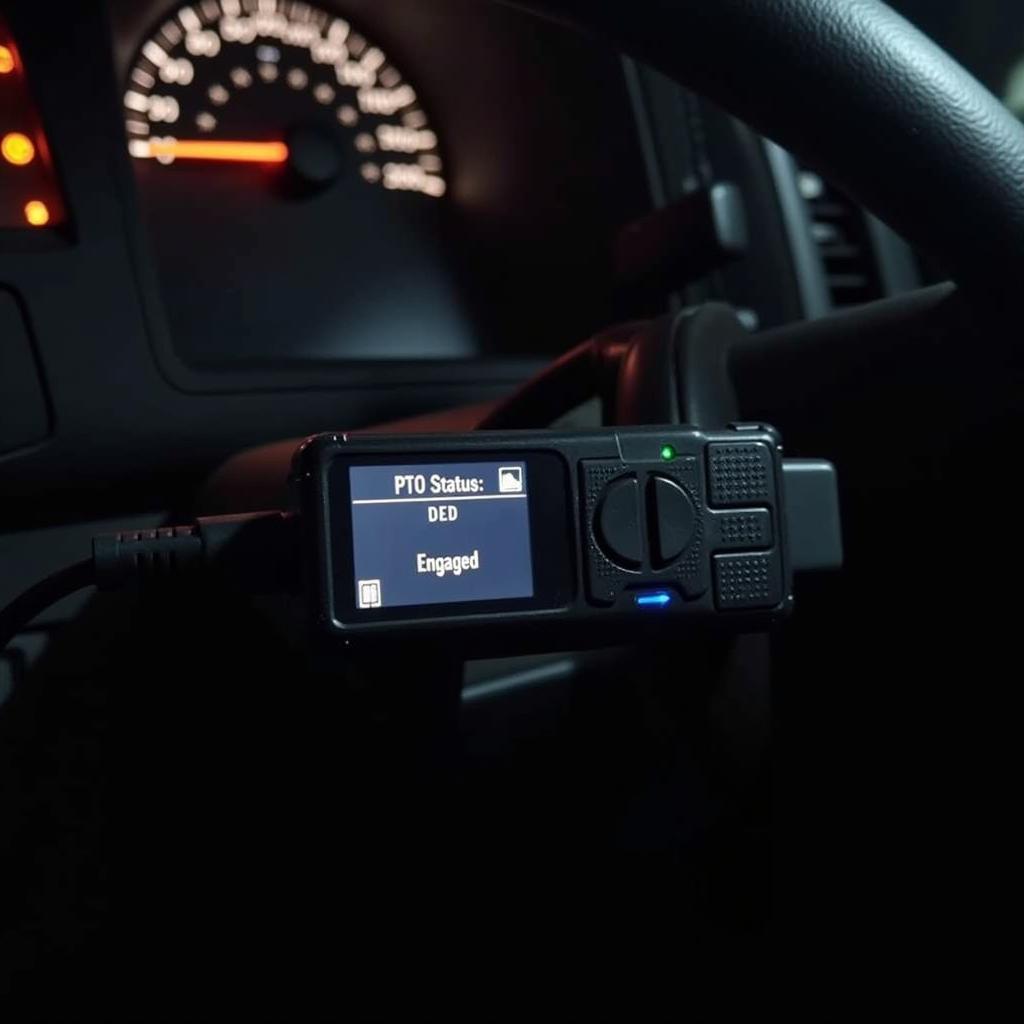The term “OBD2 PTO status” might seem like jargon, but it’s a crucial concept for anyone who uses their vehicle for more than just commuting. This status signal, accessible through your vehicle’s OBD2 port, can provide valuable insights into the operation and health of your power take-off (PTO) system. Whether you’re a seasoned mechanic or a truck owner wanting to learn more, understanding this signal can be incredibly beneficial.
What Does “OBD2 PTO Status” Mean?
Let’s break it down:
- OBD2: This stands for On-Board Diagnostics, specifically version 2, which is a standardized system in most vehicles manufactured since 1996. This system allows external devices, like scanners, to communicate with your vehicle’s computer and access data.
- PTO: Power Take-Off refers to a mechanism that transfers power from the engine to auxiliary equipment. This is commonly used in trucks, construction vehicles, and emergency vehicles to power things like hydraulic pumps, winches, and generators.
- Status: This simply means the current condition of the PTO system as reported by your vehicle’s computer.
In essence, “OBD2 PTO status” refers to the information your vehicle’s computer stores about the current state of your PTO system. This data can be accessed through the OBD2 port using a compatible scanner.
Why is OBD2 PTO Status Important?
Understanding the status of your PTO system is vital for several reasons:
- Safety: Knowing if your PTO is engaged or disengaged is crucial for safe operation. Accidentally engaging the PTO while someone is working near the connected equipment can lead to serious injuries.
- Diagnostics: The OBD2 PTO status can help diagnose issues within the system. For instance, if the status indicates engagement when the PTO switch is off, it might signal a faulty switch or wiring problem.
- Preventative Maintenance: Monitoring PTO usage, engagement/disengagement cycles, and potential fault codes can help anticipate maintenance needs, preventing costly downtime and repairs in the future.
How to Check OBD2 PTO Status
To access this information, you’ll typically need an OBD2 scanner, preferably one that specifically supports PTO data reading.
- Locate your vehicle’s OBD2 port. It’s usually located under the driver’s side dashboard.
- Connect the OBD2 scanner to the port.
- Turn the ignition on but don’t start the engine.
- Navigate to the PTO section on the scanner’s menu.
The scanner should display the current PTO status, often as “engaged” or “disengaged.” It might also provide additional data, such as:
- PTO engagement time: Useful for tracking usage and planning maintenance.
- PTO speed: Indicates the rotational speed of the PTO shaft.
- Fault codes: Point towards specific issues within the system.
Common OBD2 PTO Status Issues and Troubleshooting
While accessing the PTO status is relatively straightforward, there can be some hiccups along the way.
- Scanner Compatibility: Not all OBD2 scanners can read PTO data. Ensure your scanner explicitly mentions this capability. You can find highly-rated OBD2 USB dongles on our website.
- No Data Displayed: If the scanner doesn’t show any PTO-related information, it could be due to incompatibility or a communication error between the scanner and the vehicle’s computer. Trying a different scanner or checking the connection might help.
- Inaccurate Data: Faulty sensors or wiring issues within the PTO system can lead to incorrect data being displayed. In such cases, a qualified mechanic should be consulted.
“Understanding the PTO system’s nuances can be incredibly valuable, especially when troubleshooting.” – Mark Johnson, Automotive Engineer
Beyond the Basics: Advanced PTO Monitoring
While basic OBD2 scanners can provide essential information, advanced systems offer even greater insights. Fleet management solutions, for example, can track PTO usage across multiple vehicles, optimize maintenance schedules, and improve overall operational efficiency.
Conclusion
Understanding your vehicle’s “OBD2 PTO status” is no longer a mystery reserved for mechanics. With the right knowledge and tools, you can monitor your PTO system, diagnose potential issues, and ensure its safe and efficient operation. Whether it’s for personal use or managing a fleet of work vehicles, accessing this information empowers you to make informed decisions about maintenance and operation.
FAQ
1. Can I check OBD2 PTO status without a scanner?
No, you’ll need an OBD2 scanner that specifically supports PTO data reading.
2. Is OBD2 PTO status data recorded?
Some vehicles might store a history of PTO engagement, but this varies depending on the make and model.
3. My OBD2 scanner shows a PTO fault code. What should I do?
Consult your vehicle’s repair manual or a qualified mechanic to understand and address the specific fault code.
4. Can I install a PTO system on any vehicle?
No, not all vehicles are designed to accommodate a PTO system. Check your vehicle’s specifications and consult a professional for installation.
5. Does the OBD2 PTO status affect fuel efficiency?
Yes, engaging the PTO consumes engine power, which can decrease fuel efficiency.
Need more help with OBD2 or PTO systems? Contact us via WhatsApp: +1(641)206-8880, Email: [email protected]. Our 24/7 customer support team is ready to assist you. You can also find more information on our blog, including a helpful article on OBD2 Subaru vehicles.


